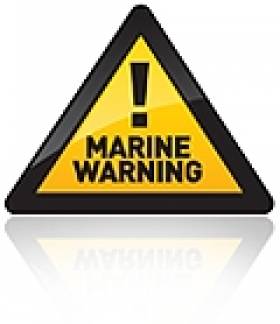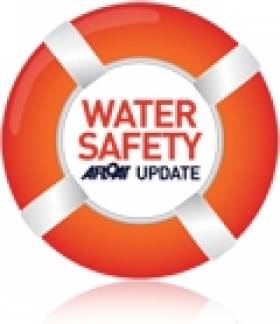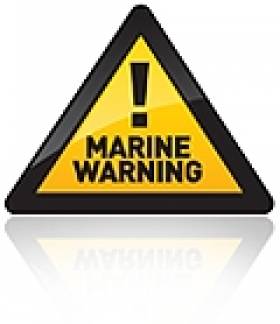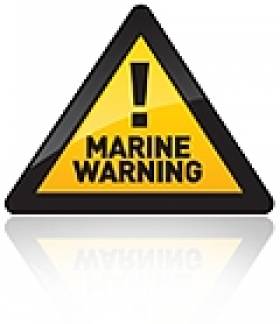Displaying items by tag: Marine Notice
Marine Notice: Rock Placements Off Co Dublin & Buoy Deployments Off West Cast
#MARINE WARNING - The latest Marine Notices from the Department of Transport, Tourism and Sport (DTTAS) advise mariners to keep a look-out for rock placement off north Co Dublin and buoy placements off Co Mayo and Co Clare.
Operations were due to commence on Saturday 8 September at North Beach in Rush, Co Dublin for the placement of rocks offshore and in the Irish Sea for a period of 10-12 days weather permitting.
The works are being undertaken by DPFPV Tideway Rollingstone (call sign PHYR) and DPFPV Stornes (call sign PCKX) at various locations detailed in Marine Notice No 49 of 2012, a PDF of which is available to read or download HERE.
These vessels are operating on a 24-hour basis and will display appropriate days shapes and lights. They are also transmitting an AIS signal and will keep a listening watch on VHF Channel 16 for the duration of the works, which involve the deployment of survey ROVs and fall pipe that will restrict the vessels' movements. All mariners are instructed to give a wide berth.
Meanwhile off the west coast, ESB International has deployed two Waveroder buoys as positions near Achill Island in Co Mayo and Doonbeg in Co Clare.
The Achill buoy will be operational for a minumum of three months from now, while the Killard buoy will be operational for a minimum of 10 months having been recently relocated. Both are spherical and yellow in colour. All vessels are requested to give the buoys a wide berth.
Full details of their positions are included in Marine Notice No 50 of 2012, a PDF of which is available to read or download HERE.
Marine Notice: Undersea Cable Repairs Off Kilmore Quay
#MARINE WARNING - In its latest Marine Notice to mariners in the Irish Sea, the Department of Transport, Tourism and Sport (DTTAS) advises of cable repairs being carried out east of Kilmore Quay in Co Wexford.
Operations commenced yesterday 6 September and will continue till approximately next Thursday 13 September, subject to the weather. The works will be undertaken by C/S Peter Faber (call sign FLEV).
During repairs the vessel will be links to the seabed by the cable and will have poor manoeuvrability. This will be signalled with shapes and/or lights as required. The vessel will also broadcast regular safety messages to give details of activity and position.
All vessens in the area, especially those engaged in fishing, are requested to give a wide berth, and not to pass between the repair vessel and the shore.
Full details, including co-ordinates, are included in Marine Notice No 48 of 2012, a PDF of which is available to read or download HERE.
Marine Notice: Construction Work in Dingle Harbour
#MARINE WARNING - The latest Marine Notice from the Department of Transport, Tourism and Sport (DTTAS) advises on construction works at An Daingean Fishery Harbour Centre in Co Kerry scheduled to commence today 3 September 2012, weather permitting.
The works will take place at the mouth of Dingle Harbour, to the south east of Flaherty Point (co-ordinates: 52 07.235’ North, 010 15.711’ West) and will involve the installation of a new navigation beacon, five metres in height.
The works are being advanced by the Marine Engineering Division of the Department of Agriculture, Food and the Marine. The construction will involve use of a work vessel 20m × 7m in size carrying civil engineering plant and machinery, as well as other smaller work vessels and platforms. The work vessel will display the relevant day signals and navigation lights in accordance with the Collision Regulations.
For safety reasons, mariners are requested to proceed slowly and with caution in the approach to the entrance to Dingle Harbour and to give the works a wide berth. Wave-wash from vessels should be avoided.
These works are expected to be on-going until the end of October 2012, weather permitting.
Marine Notice on Legal Requirements for Personal Flotation Devices
#WATER SAFETY - The latest Marine Notice from the Department of Transport, Tourism and Sport (DTTAS) addresses the legal requirements for all recreational craft owners, masters and users in relation to the wearing and carrying of personal flotation devices (PFDs).
The notice discusses the different types of PFDs - lifejackets and buoyancy aids - and their performance standards, as well as highlighting the importance of their use, proper care and servicing for safe activities on the water.
The law makes clear that there must be suitable PFDs for everyone on board any pleasure craft, and that PFDs must be worn by anyone the deck of any craft or on board any open craft that is under seven metres in lengh - or for people under the age of 16, any craft regardless of length.
Also detailed are recommendations for the storage of PFDs, and guidance for their correct usage.
The use of lifejackets and buoyancy aids is particularly important in light of the recent Marine Casualty Investigation Board (MCIB) recommendations on a number of incidents where their availability could have saved lives.
Full details are included in Marine Notice No 45 of 2012, a PDF of which is available to read or download HERE.
Marine Notice: Recall of Mullion COMPACT 150N Lifejackets
#MARINE NOTICE - The Department of Transport, Tourism and Sport (DTTAS) has issued a Marine Notice (No 37 of 2012) advising of the recall of certain lifejackets manufactured by Mullion due to a potential problem with their inflation.
In order to avoid any potential safety issue, Mullion is recalling for inspection all COMPACT 150N ISO 12402 lifejackets which have been sold since 1 December 2011 if they have a yellow valve in the oral tube.
COMPACT lifejackets with a red valve in the oral tube are not affected by this recall.
Owners are warned not to use the affected lifejackets and to return them immediately to the nearest Mullion Lifejacket Service Station or the Mullion factory. See www.mullion-pfd.com/compact-life-jacket-recall-programme for more information.
#MARINE NOTICE - The latest Marine Notice from the Department of Transport, Tourism and Sport (DTTAS) reminds mariners to familiarise themselves with the operation of the distress alert button on GMDSS marine radio equipment.
Radio communications fitted on board Irish ships and fishing vessels with distress button capability, such as DSC or GMDSS-compliant satellite terminals, are fitted with a distress button which initiates an automatic distress alert on maritime mobile distress frequencies. This includes the identification of the vessel and may include its position.
The Maritime Radio Affairs Unit wishes to bring to the attention of GMDSS marine radio operators the Guidance on Distress Alerts contained in the IMO Circular COMSAR.1/Circ.45 which can be found HERE.
Owners and operators should ensure that this notice is posted at all VHF, MF, HF, DSC Digital Selective Calling and all GMDSS approved maritime satellite communications equipment.
Complete details for shipowners, fishing vessel owners, shipmasters and seafarers are included in Marine Notice No 36 of 2012, a PDF of which is available to read and download HERE.
#MARINE NOTICE - The latest Marine Notice from the Department of Transport, Tourism and Sport (DTTAS) warns mariners off Gormanston, Co Meath of live surface-to-air firing practices over two days next week.
The Defence Forces will be conducting the live firing exercises at Gormanston Air Defence Range on 3 and 4 July 2012 from 8am to 6pm each day.
The danger area comprises the lands of Gormanston Aerodrome and the Air and Sea areas contained within a radius of 3 nautical miles centred on Gormanston Aerodrome, with an additional area contained within a segment centred on Gormanston Aerodrome and bearing of 015º degrees true, through Mosney Railway Station and 106º degrees true, through Gormanston Railway Station seawards for a distance of 10 nautical miles.
For the periods whilst the Range is active the sea zone within the danger area is excluded to all vessels. A Naval Service vessel will enforce the exclusion zone ‘D1’, which is indicated on British Admiralty Chart No 44.
All vessels are advised that they are required to remain outside of the exclusion zone whilst the Range is active. All vessels in the area are also recommended to carefully monitor the Radio Navigation Warnings that will be broadcast during the firing period.
Marine Notice: Standards of Materials, Fixtures and Fittings Acceptable on Class-Exempt Unlicensed Vessels
#MARINE NOTICE - The latest Marine Notice from the Department of Transport, Tourism and Sport (DTTAS) outlines the standards of materials, fixtures and fittings acceptable for use on class-exempt unlicensed vessels, defined as boats carrying passengers for the purpose of angling on smooth water voyages.
The notice is supplementary to the Licensing of Passenger Boats (Exemption) Regulations 2002 and the subsequent amendment of the same year, and it supersedes the particulars of Marine Notice No 1 of 2003.
The standards outlined within require that the hull, machinery and equipment of any vessel should be properly designed, fit for its intended purpose and in good condition so as to ensure to the safety of all on board.
Guidance is provided on what is to be considered adequate, suitable and approved in relation to the hull, machinery, items, fixtures and fittings on any vessel.
Generally, any item of equipment that bears the Marine Equipment Directive Mark of Conformity is considered complying with the 2002 regulations.
The notice also provides direction on pre-departure safety checks and briefings, and defines the appropriate areas of operation for the class exemption.
Complete details for all boat builders, boat repairers, owners and users are included in Marine Notice No 27 of 2012, a PDF of which is available to read and download HERE.
#MARINE NOTICE - The Department of Transport, Tourism and Sport (DTTAS) has issued a safety notice for all users of Electronic Chart Display and Information Systems (ECDIS).
Following an announcement by the International Maritime Organization (IMO) concerning potential display anomalies in some ECDIS systems, the International Hydrographic Organization (IHO) issued an 'ENC Data Presentation and Performance Check' in October 2011 to assist mariners and help determine the extent of the issues.
Reports from sea received by the IHO confirm that a number of manufacturers’ ECDIS fail to display some significant underwater features in the 'Standard' display mode.
As a result, these ECDIS must be operated in 'Full display' or 'All display' mode in order that all significant objects are visible to the mariner until a software upgrade is made available.
The notice also warns that earlier versions of the ECDIS manufactured by the Japan Radio Co (JRC) will not display some types of wreck and underwater obstructions (including stranded wrecks) in any display mode. These models of JRC ECDIS must be used in conjunction with paper charts, and affected mariners should contact JRC or their suppliers to arrange remedial action.
More details are included in Marine Notice No 23 of 2012, a PDF of which is available to read or download HERE.
#MARINE NOTICE - The latest Marine Notice from the Department of Transport, Tourism and Sport (DTTAS) details amendments to the European Communities (Vessel Traffic Monitoring and Information System) Regulations.
The change gives effect in Irish law to various amendments in an EU directive last year pertaining to the present EU vessel traffic monitoring and information system for the marine sector.
Of note in the new legislation is the inclusion of certain exemptions from the requirement for mariners to carry an AIS and/or (S-)VDR on board their vessels for tracking and data recording respectively, as well as the removal of the obligation to use SafeSearchIreland for mariners placing themselves at the disposal of the Irish Coast Guard.
Complete details of these exemptions and other amendments are included in Marine Notice No 22 of 2012, a PDF of which is available to read and download HERE.






































































